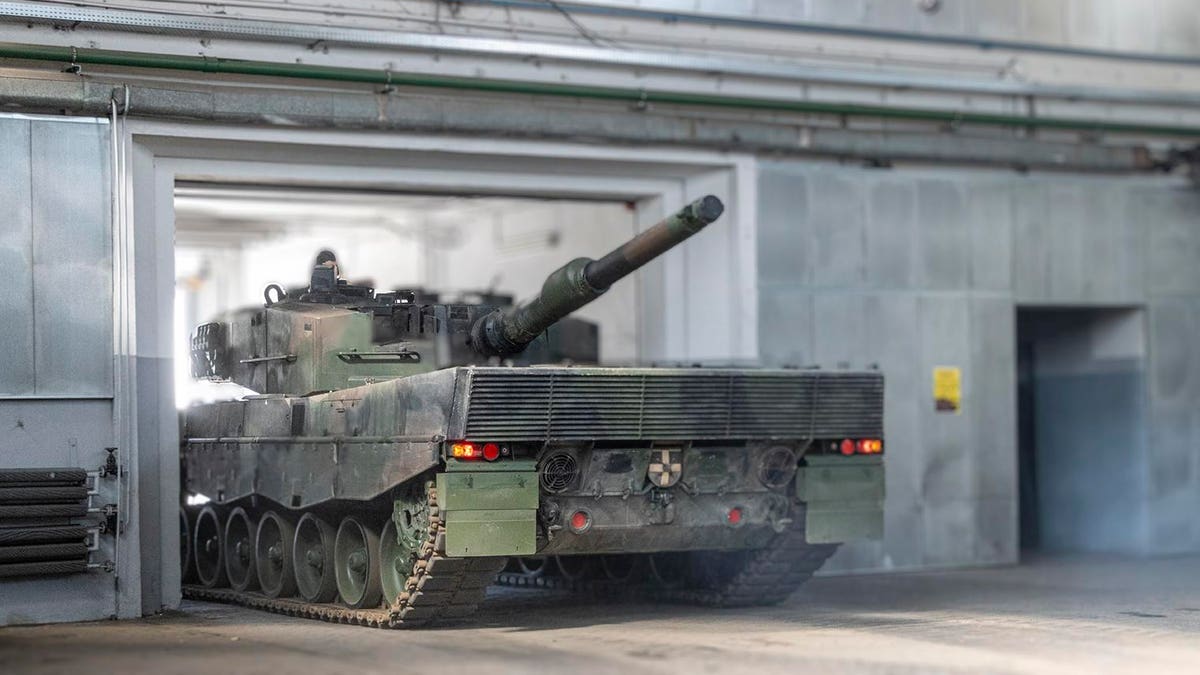The first battle-damaged Ukrainian Leopard 2A4 tank has left its repair depot in Poland. Fully fixed and again ready for combat, the 61-ton, four-person tank has made, or is making, its way back to Ukraine—first by heavylift truck and presumably then by rail.
“Work on other tanks is in progress,” Polish vehicle-maker Polska Grupa Zbrojeniowa stated.
PGZ inducted the first German-made Leopard 2A4s at its Bumar-Łabędy repair facility in Gliwice, just west of Krakow, in late July. Polish prime minister Mateusz Morawiecki dropped by the Gliwice factory to commemorate the event.
Ukraine so far has received 40 of the 54 1980s-vintage Leopard 2A4s that various NATO countries including Canada, Germany, Norway, Poland and Spain have pledged to the Ukrainian war effort.
The Leopard 2A4s represent just an eighth of the Western-style tanks Ukraine’s allies are donating. The other 350 or so tanks include ex-British Challenger 2s, ex-American M-1A2s, Strv 122s from Sweden and old Leopard 1A5s from a Danish-Dutch-German consortium.
Four hundred Western tanks might not seem like a lot of tanks for a country that deploys perhaps 2,000 tanks in all—and has lost around 500 tanks in the first 21 months of Russia’s wider war on Ukraine.
But where a Soviet-style tank can be fragile, and tends to explode when hit owing to the lack of protection around its under-turret ammunition-stowage, a Western-style tank tends to be more robust.
And it’s standard practice in European and American tank design to include blow-out panels or a water sleeve for the ammunition. Panels vent secondary explosions outward; a water sleeve forestalls ammunition cooking off.
All that is to say, when a Leopard 2A4 suffers damage, it’s not likely to be catastrophic damage. The crew can bail out. Engineers can recover the tank. Logisticians can ship it to a depot for repairs. Two months later, the tank is back at the front, as good as new.
Thus it’s accurate to say that Ukraine has lost just three of its 40 delivered Leopard 2A4s, all of which serve with the 33rd Mechanized Brigade. The brigade is part of the counteroffensive corps that’s battling along the 50-mile axis from Robotyne to Russian-occupied Melitopol in southern Ukraine’s Zaporizhzhia Oblast.
According to independent analysts, three Leopard 2A4s have totally burned out after striking mines or eating artillery shells, anti-tank missiles or explosive-laden drones—or some combination of the four. At least another four Leopard 2A4s have suffered minor or moderate damage. It’s the worst-off of these that have ridden the rails to Gliwice for deep repairs.
We can trust the unofficial counts of destroyed and damaged Leopard 2A4s, as the numbers are consistent with one very strong piece of visual evidence: a video that the 33rd Brigade posted on social media in early September, and which depicts around 30 Leopard 2A4s staged in a field all at the same time.
Almost all of the tanks in the video sport add-one reactive armor that transforms them into what observers call “Leopard 2A4Vs.” The reactive armor explodes outward when hit, blunting the destructive power of an incoming round. The armor is a recent addition, and could further reduce the chance that a damaged Leopard 2A4 will become a destroyed Leopard 2A4.
The Polish repair depot, along with separate depots for Ukrainian tanks in Poland, Germany, Romania and the United Kingdom, is critical to the Ukrainian war effort as Russia prolongs its aggression into a third year. “While others make declarations regarding the future, we act in consultation with the Ukrainian side,” PGZ stated.
It’s entirely possible most of Ukraine’s Western-made tanks will suffere damage—some more than once—but survive, get recovered, ship to a depot, undergo repair and return to the fight. So on and so forth as the war grinds on.
Read the full article here





